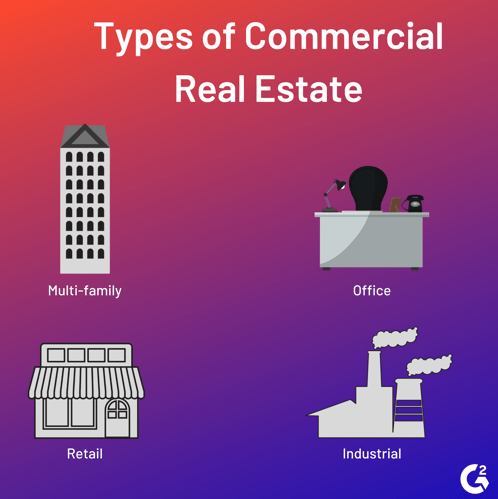

What comes to mind when you hear the term “real estate”?
For most people, it’s probably the familiar image of a well-dressed, smiling agent helping an eager buyer purchase their first home. But this isn’t the only type of real estate that exists.
Think about shopping malls, gas stations, hotels, etc. These are called commercial properties, and they fall under the umbrella of commercial real estate, which is very different from residential. Let’s look at the definition first.
Commercial real estate (CRE) refers to non-residential property that serves to generate income. This includes shopping malls, hotels, and office spaces.
In this article, we’ll take a look at commercial real estate more in-depth, including the different types of commercial properties and leasing agreements.
According to Nareit, as of 2017 the commercial real estate market in the U.S. has an estimated value of $15 trillion. Despite the massive surge in e-commerce, many companies still require a physical brick and mortar location in order to best serve their customer base. Consider all the businesses that require office space in order to run their daily operations and house their employees. The need for commercial space is massive and it’s not slowing down any time soon.
| Tip: Learn more about what a short sale is in real estate. |
Since commercial property exists to generate income, the buyers are usually real estate investors or business owners. Similar to residential real estate, these buyers have the option of hiring an agent who specializes in selling commercial properties to help them in their search for the right space.
In order to gain a strong understanding of the commercial sector, it’s important to know the most common types of commercial properties. Let’s get started.
Since different properties serve different business functions, they are separated into four major categories:

Multi-family refers to properties with multiple units, often referred to as dwellings, all within one structure. A good example of a multi-family property is an apartment building. You may be thinking, “But aren’t apartment buildings residential?”
The answer is yes, but only if they have less than 5 units. Any buildings with 5 or more units are considered commercial property. This is because, in most cases, the owner of the building purchased it primarily to generate income from the rental units, not to live in it.
Multi-family properties are further categorized by location (urban or suburban) and the size of the building:
People move around a lot, which is why most lease agreements for multi-family properties are short-term. Despite the shuffling of tenants, the profitability of a large apartment building is rarely ever affected by having a few vacant units. For this reason, this type of property is considered one of the safer options for investors.
Learn more about the 7 types of commercial leases here.
Office buildings are equipped to provide tenants with space for cubicles, conference rooms, a reception area, etc. Most companies don’t want to move their entire workforce around frequently, which is why it’s common for office leases to be long-term.
In general, office buildings are classified into three different groups:
The classification tiers were made standard by the Building Owners and Managers Association (BOMA) to encourage reporting of office conditions and comparison between structures. The class categories are meant to serve as a guideline, not be definitive.
| TIP: These guidelines are subjective and largely dependent on the local market. A Class B structure could be considered a Class A structure in a different neighborhood. |
The retail category includes anything ranging from a neighborhood strip mall to large shopping and entertainment centers. Traditionally, retail space is more expensive per square foot than office space is. That’s because businesses looking to buy or rent this type of property are primarily focused on foot traffic. Similar to office buildings, most commercial retail leases are long-term and could range anywhere from 5 to 10 years.
Most retail properties will have one or several “anchor tenants” which are big name brands that have the largest space on the lot. These anchors often have the biggest names on the marquee and are responsible for bringing in the most foot traffic to the shopping area.
The industrial sector of commercial real estate includes buildings such as warehouses and other types of manufacturing or distribution facilities. They are commonly located outside of residential or urban areas, and occupied by a single tenant. Since the primary function of these buildings is industrial, there are normally zoning regulations that must be followed.
While there isn’t technically a fifth category, there are other properties that fall under the commercial umbrella that don’t fit into any of the sectors we’ve already covered. This includes properties like hotels, hospitals, nursing homes and self-storage buildings which are all for-profit establishments and therefore, commercial.
There isn’t a big difference between selling commercial vs. residential real estate. Agents are still required to take classes and pass a licensing exam in the state they live and work in. After earning their license, most agents will begin their careers in residential before moving on to the commercial sector.
Similar to residential agents, professionals working in commercial real estate spend the majority of their time working with their clients. The big difference is that the clients are going to be investors or businesses, instead of individuals or families. There will be agents who work solely for businesses to help them find a space to rent, and there will be agents that work solely with investors who are looking to buy. Some agents will do both - it really depends on the individual.
If you're looking more insight into the working lives of agents and the real estate industry as a whole, check out this list of 60 relevant industry statistics to know in 2019.
The commercial sector isn’t exactly what comes to mind when most people think of real estate. That being said, the commercial market is constantly changing and has potential to be very lucrative for agents who choose to go this route.
Izabelle is a Partner Marketing Specialist at InStride and a former content specialist at G2. Outside of work, she is passionate about all things pop culture, food, and travel. (she/her/hers)
For a real estate agent, complicated negotiations are just part of the job.
 by Izabelle Hundrev
by Izabelle Hundrev
Most people are familiar with the role of real estate agent, but what about the person who...
 by Izabelle Hundrev
by Izabelle Hundrev
The business of real estate is always changing.
 by Izabelle Hundrev
by Izabelle Hundrev
For a real estate agent, complicated negotiations are just part of the job.
 by Izabelle Hundrev
by Izabelle Hundrev
Most people are familiar with the role of real estate agent, but what about the person who...
 by Izabelle Hundrev
by Izabelle Hundrev
Never miss a post.
Subscribe to keep your fingers on the tech pulse.


